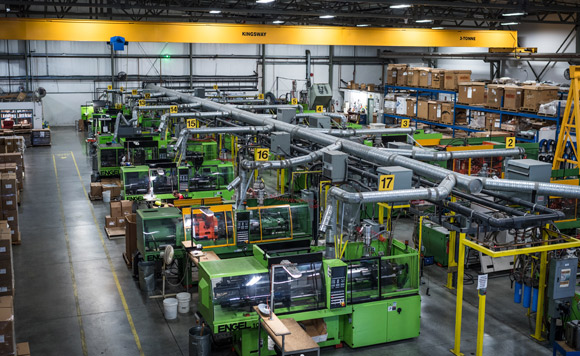by Cassidy Nunn –
The Scotty name, which is well known in the fishing world, made famous by their downriggers and rod holders, is also recognizable out here on the Peninsula with the company’s roots going deep within the local community.
If you’re not a fishing aficionado, perhaps you’ve only driven by the massive Scotty Manufacturing building in the industrial park area by the airport and wondered at what might go on inside the 90,000-square-foot building. I recently had the chance to take a company tour with Chris Root, a Project Manager with Scotty Manufacturing, and go behind the scenes to see how a rod holder, one among many of their hundreds of products, is produced.
Scotty Manufacturing began back in 1952 when founders Blayney and Almeda Scott, a husband-and-wife team, saw a need within the fishing industry and decided to try their hand at manufacturing the parts out of plastic. The original location was a 2,000-square-foot building in James Bay but after many additions at that location, they relocated to Sidney in 2000. The current location was expanded two years ago and just about every job is done in house, from assembly, packaging, shipping and sales to marketing, engineering and production. “We do as much as possible in house and locally sourced,” says Chris. “We build our own injection molds in house and try to minimize outsourcing components from abroad whenever possible.” Scotty doesn’t manufacture single-use disposable products, and recycles and re-uses materials as much as possible.
The Scotty name is now known for three lines of products: Marine Fishing, Paddle Sport and Fire, of which there are many different products within each line. The fishing line is the oldest and contains the most variety of products, from downriggers to line pullers to fishing rod holders. The paddle sport line came about after seeing a rise in kayak fishing and so the need for the fishing accessories to be able to fit on a kayak or smaller vessel. The Scotty Fire line produces products for the firefighting industry such as nozzles, couplers for hoses and various valves and connectors.
The company is still family run and employs approximately 100 people internally, with many long-term employees. Chris is one such employee, having worked for the company in a wide variety of roles over the past 19 years; he walked me through the process of creating a fishing rod holder, from the design concept to the finished product. Once the initial concept and design of the product has been made, it then is handed off to the engineers who draw it and print 3D models so they can then be tested and any modifications to the design can be completed. Next is the making of the injection mold in the onsite machine shop, which then goes to the molding floor and is inserted into one of the 17 injection molding machines that manufacture all the plastic components. “Raw plastic comes in the front door, finished product goes out the back door,” says Chris after showing me what a bin of raw plastic looks like, some a solid colour, others plain white. The molding floor runs 24 hours a day, six days a week; it takes approximately three hours to get the machines from dead cold up to running temperature. Once the rod holder has been made, it’s assembled and packaged in house, and then prepared for shipping. There is no retail store at the facility, so all orders are done through dealers and sold through various retail locations around the world. They do, however, have an on-site repair shop which services their products as many have long warranties.
At the end of my tour, Chris takes me up to the top floor to look down onto the widespread operation. It’s impressive to see the scale of the company, all the huge machines and various departments all under one roof. I’m the Scotty line will continue to be one known for innovation.
Photo by Nunn Other Photography.




